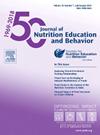Examination of the Relationship Between Intestinal Conditions, Food Preferences, and Food Intake in 3–5-year-old Children and Their Parents
IF 2.3
3区 医学
Q2 EDUCATION, SCIENTIFIC DISCIPLINES
引用次数: 0
Abstract
Background
Food-related preferences and practices are formed during early childhood. However, they are very complicated. Recently, it has been suggested that intestinal conditions are related to various psychological conditions. Data showing the relationship between intestinal conditions, food preferences, and nutritional intake, particularly in children and their parents, are limited. Parents have a large influence on the eating habits of children; therefore, we investigated the relationship between the intestinal condition of parents and their eating habits.
Objective
This study examined the relationship between intestinal conditions, food intake, and food preferences in healthy young children and their parents.
Study Design, Settings, Participants
In this cross-sectional study, 320 pairs of children and their parents were randomly selected. Parents who consented to the study answered the questions and submitted a questionnaire in 2024 (77.8% returned).
Measurable Outcome/Analysis
The questionnaires comprised self-rated health (SRH), Brief Self-Administered Diet History Questionnaire for adults and children (BDHQ and BDHQ3Y, respectively), food preferences, and intestinal conditions. If there were any foods that they disliked, they were instructed to choose from 55 items. “Intestinal conditions” were assessed using 24 questions. For example, the fewer checks they need to make, such as whether your stool smells bad, the more comfortable their bowls are. Correlation coefficients were calculated using Spearman’s rank correlation coefficient or Pearson’s correlation coefficient.
Results
The ages of the parents and children were 37.1 ± 5.1 and 4.4 ± 1.0 years, respectively. A positive correlation was found between the intestinal conditions of children and their parents. For both children and their parents, a low intestinal condition was negatively correlated with poor SRH. In children, low intestinal activity was significantly associated with several disliked foods and low vegetable intake. The correlation coefficients between vegetable intake and vitamin C, folic acid, vitamin A, vitamin K, and dietary fiber were ≥0.6.
Conclusions
Improving children’s food preferences and increasing their vegetable intake may improve their health, including their intestinal conditions.
Funding
None
3 - 5岁儿童及其父母肠道状况、食物偏好和食物摄入关系的研究
与食物有关的偏好和做法是在幼儿时期形成的。然而,它们非常复杂。最近,有人提出肠道疾病与各种心理状况有关。显示肠道状况、食物偏好和营养摄入之间关系的数据有限,特别是儿童及其父母的数据。父母对孩子的饮食习惯有很大的影响;因此,我们调查了父母肠道状况与饮食习惯的关系。目的探讨健康幼儿及其父母肠道状况、食物摄入和食物偏好之间的关系。研究设计、环境、参与者在这项横断面研究中,随机选择了320对儿童及其父母。同意本研究的家长于2024年填写问卷,回复率为77.8%。可测量的结果/分析问卷包括自评健康(SRH)、成人和儿童简短自填饮食史问卷(分别为BDHQ和BDHQ3Y)、食物偏好和肠道状况。如果有他们不喜欢的食物,他们被要求从55种食物中选择。“肠道状况”通过24个问题进行评估。例如,他们需要做的检查越少,比如你的大便是否难闻,他们的碗就越舒服。相关系数采用Spearman等级相关系数或Pearson相关系数计算。结果父母年龄为37.1±5.1岁,患儿年龄为4.4±1.0岁。研究发现,儿童的肠道状况与其父母之间存在正相关。对于孩子和他们的父母来说,低肠道状况与低SRH呈负相关。在儿童中,肠道活动低与几种不喜欢的食物和低蔬菜摄入量显著相关。蔬菜摄入量与维生素C、叶酸、维生素A、维生素K、膳食纤维的相关系数均≥0.6。结论改善儿童饮食偏好,增加蔬菜摄入量可改善儿童的健康状况,包括肠道状况。FundingNone
本文章由计算机程序翻译,如有差异,请以英文原文为准。
求助全文
约1分钟内获得全文
求助全文
来源期刊
CiteScore
4.20
自引率
11.50%
发文量
379
审稿时长
44 days
期刊介绍:
The Journal of Nutrition Education and Behavior (JNEB), the official journal of the Society for Nutrition Education and Behavior, is a refereed, scientific periodical that serves as a global resource for all professionals with an interest in nutrition education; nutrition and physical activity behavior theories and intervention outcomes; complementary and alternative medicine related to nutrition behaviors; food environment; food, nutrition, and physical activity communication strategies including technology; nutrition-related economics; food safety education; and scholarship of learning related to these areas.
The purpose of JNEB is to document and disseminate original research and emerging issues and practices relevant to these areas worldwide. The Journal of Nutrition Education and Behavior welcomes evidence-based manuscripts that provide new insights and useful findings related to nutrition education research, practice and policy. The content areas of JNEB reflect the diverse interests in nutrition and physical activity related to public health, nutritional sciences, education, behavioral economics, family and consumer sciences, and eHealth, including the interests of community-based nutrition-practitioners. As the Society''s official journal, JNEB also includes policy statements, issue perspectives, position papers, and member communications.

 求助内容:
求助内容: 应助结果提醒方式:
应助结果提醒方式:


